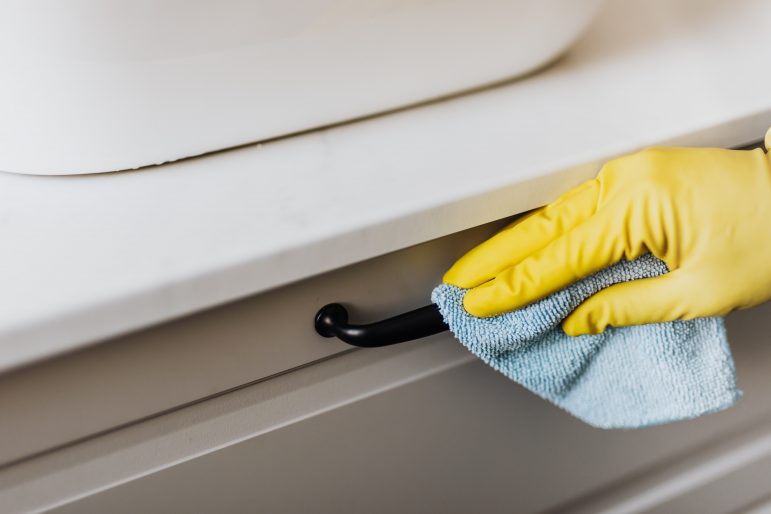Contamination of environmental surfaces plays an important role in the spread of infections like gastroenteritis, hepatitis, rotavirus, and norovirus. The threat of spread via surface contamination is particularly prominent in indoor facilities such as convention centres, restaurants, hospitals, schools, daycare centres, and institutions for the elderly.
Many enteric viruses have been associated with infections via hand and surface contamination. High-touch surfaces such as door handles, clothes, telephones, toilet seats, flush handles, handrails, thermometers, gloves, and papers can be easily contaminated and serve as vehicles of transmission for the virus.
Surfaces or objects can be contaminated by:
- Deposition of virus particles from the air (the greatest threat is on upward-facing surfaces)
- Direct emission through coughing, sneezing, talking, breathing, etc
- Aerosolization of enteric viruses due to vomiting, diarrhea, and toilet flushing (the threat is highest on surfaces near sources)
- Hand touching (the threat is greatest on high-touch surfaces)
What influences virus survival on surfaces?
According to Dr. Gavin Macgregor-Skinner, director of the Global Biorisk Advisory Council (GBAC), a division of ISSA, the prevention of enteric virus-related infections requires a strong understanding of virus persistence in the environment and the role of contaminated surfaces and objects in virus transmission.
Factors that influence survival of enteric viruses on surfaces include the virus itself, surface properties, and extrinsic environmental factors, such as temperature or humidity.
Enteric viruses are nonenveloped and have been reported to persist on surfaces for several weeks to month, with Hepatitis A virus and rotavirus proven to be particularly resistant. Available data suggests that most viruses persist longer on nonporous surfaces, but this also depends on the viral type.
Environmental factors including air temperature and humidity can also play a part, but the length of virus viability may also depend on the cleanliness of the surface. In particular, low temperatures have been reported to promote a longer persistence, and decreases in humidity can preserve the infectivity of hepatitis A virus, rotavirus, and adenovirus. Humidity level is thought to play an important role in virus persistence in the environment, and it has been suggested to explain the seasonality of rotavirus infections.
Evidence of surface transmission
Direct evidence of surface contamination and resultant virus transmission is difficult to obtain because other routes, such as person-to-person transmission, are usually suspected.
Examples of enteric viruses found on surfaces and fomites associated with disease outbreaks include:
- Rotaviruses on fomites in child daycare centres, pediatric hospital units, and hospital intensive care units; and on toys associated with an outbreak in a pediatric oncology unit.
- Noroviruses found on surfaces and objects around patients during outbreaks in hospitals, hotels, aircraft, and cruise ships.
- Adenovirus contamination of surfaces in hospitals and pediatric units.
- Astroviruses on environmental surfaces detected during a hospital outbreak.
The U.S. Centers for Disease Control and Prevention (CDC) states that adenoviruses spread from infected people to others through close personal contact, such as touching or shaking hands, via the air by coughing and sneezing, and by touching objects or surfaces with adenoviruses on them then touching your mouth, nose, or eyes. They can survive on surfaces for more than one month between 39-68°F (4-20°C) and survive longer on paper than on aluminum.
Meanwhile, astroviruses can survive for a long time on both porous and nonporous surfaces, mostly at low temperatures and on porous surfaces. Enteroviruses like coxsackieviruses can remain viable on hard, nonporous surfaces for upwards of two weeks in conditions of high and low temperature and humidity. Hepatitis A can survive for more than two months on surfaces and has better resistance on nonporous surfaces — for instance, it can remain infectious for at least one month at room temperature on the flush handle of a toilet. Norovirus can make a person sick through only a minimal amount of norovirus particles, which can remain infective beyond 70 days on stainless steel and plastic at both 44°F or 7°C and room temperature. Finally, rotavirus is particularly resistant to most disinfectant products and can survive for a few hours on human hands and days on hard surfaces. It had also been found to remain infectious on a metal surface for at least two months at various temperatures and humidity levels. Surfaces likely to be contaminated include infected individuals’ hands, doorknobs, sinks, toilets, and faucets.
The role of surface contamination in disease spread
Surface contamination can cause a knock-on “network” effect wherein more and more surfaces get contaminated if not sufficiently disinfected.
Studies conducted on aeroplanes concluded that the commonly repeated advice to wash hands frequently might be replaced by more strategic advice, such as to immediately clean surfaces or advice based on who should wash their hands, and when.
Macgregor-Skinner concludes that “we know that contaminated surfaces and objects can transmit diseases and improving surface cleaning and hand hygiene can decrease infection.” He notes the CDC recommends cleaning and disinfecting high-touch surfaces on a more frequent basis than minimal-touch surfaces.
“In practice, the most significant public health gain would be implementing a strategy involving more routine surface cleaning and disinfection and increased hand hygiene practices to significantly reduce the risk of viral transmission in any indoor space.”







